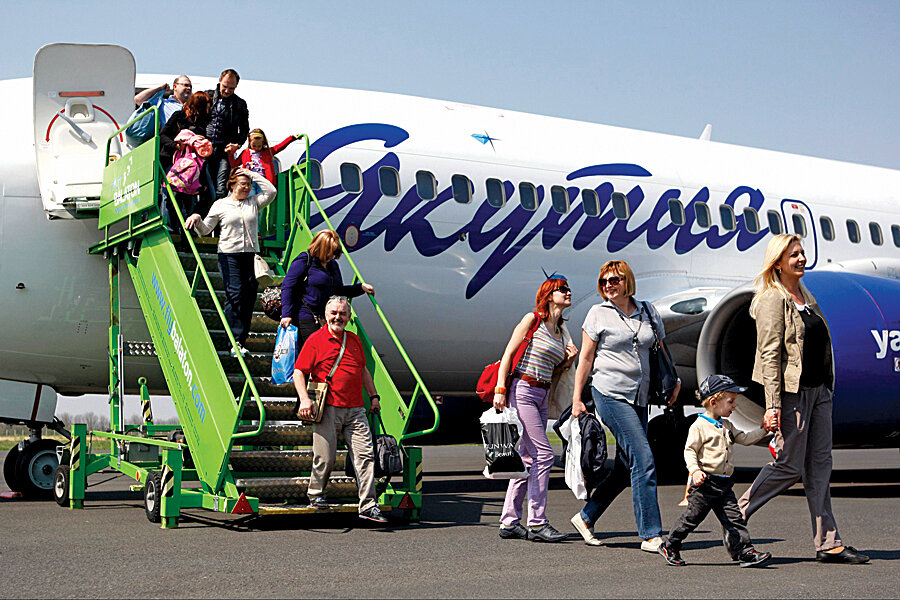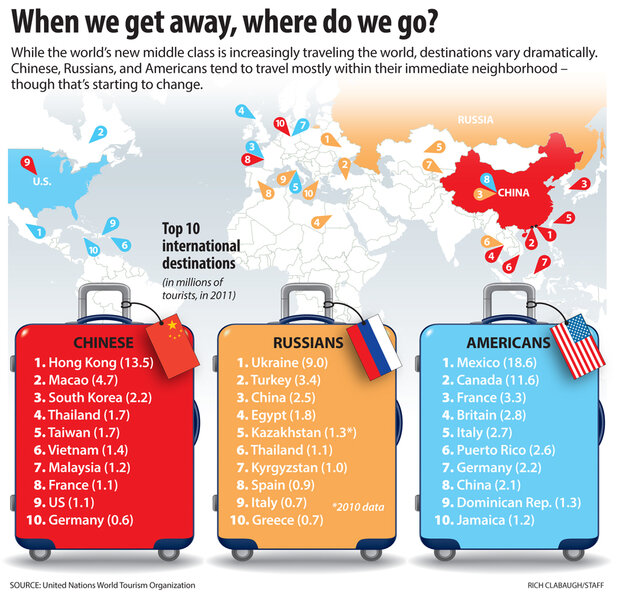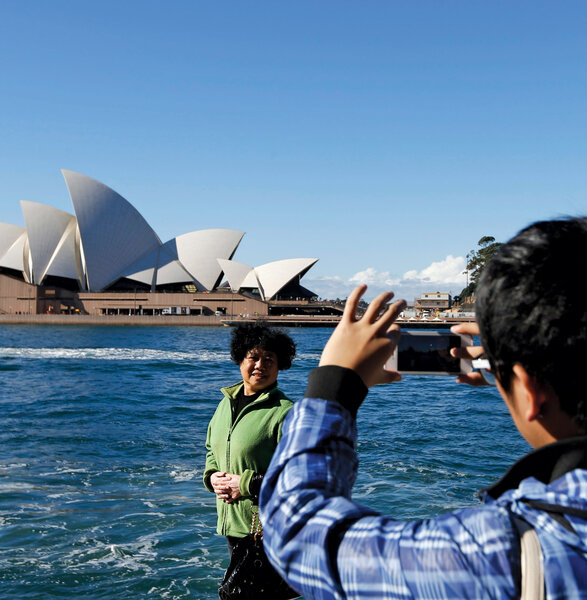The world goes on vacation
Loading...
| Paris; Beijing; Moscow; Rio de Janeiro; Seoul, South Korea; Karachi, Pakistan; and Johannesburg, South Africa
It's the thick of summer, at least for those of us in the Northern Hemisphere. And for many, that means it's time for the long-awaited annual vacation.
It can be about discovery, de-stressing, and spending time with those dearest to us. But vacation trends vary by geography, and they change with the times.
People's vacation choices shed light on this year's shifting patterns of globalization, which have been dominated by the rise of emerging economies.
While European travel is down, Russians, Chinese, Brazilians, and others are traveling abroad as never before. International tourism from advanced countries is projected to grow by 2.2 percent annually, while from emerging countries the rise will be double that. By 2030, 1 billion tourists from emerging economies will travel across borders.
These new travelers are part of a new global middle class that is traveling internationally for many reasons: to see parts of the world once closed off, to sample shopping abroad, to take advantage of cheaper and safer travel opportunities outside their own country, or to satisfy their curiosity. The Internet has already closed global divides, but it's the face-to-face contact tourists can have with locals in a cafes or street markets that ultimately provides deeper cultural understanding.
Take Russia, for example. Russians are relative newcomers to the global tourist scene. For much of the past century they were locked up inside the former Soviet Union, and most travel opportunities came in the form of a few weeks at a state-run sanitarium on the Black Sea or a Volga River cruise. Even now, the concept of a standard vacation is not of travel far and wide, but, as in the old days, to a dacha in the countryside to commune with nature and put down vegetables for winter consumption.
After the collapse of the USSR, it was mainly the freshly enriched "new Russians" who could travel abroad, earning a reputation for themselves, mainly across Europe, as loud and abrasive guests and wildly extravagant spenders.
Over the past decade, however, the relative mass prosperity of the Vladimir Putin years has created a new type of Russian tourist, a genuinely middle-class traveler who is stepping out into the world for the first time. "More than half of Russians these days prefer to leave home," says Yury Barzykin, vice president of the Russian Union of Tour Operators, an industry group.
These new travelers tend to be far more budget-conscious than their "nouveau riche" cousins, and also quieter, as well as more curious and respectful of foreign cultures. Millions of them flock each summer to eastern Mediterranean countries such as Turkey, Egypt, and Cyprus, where tour operators have designed cheap, often all-inclusive, Russian-speaking packages for them, and governments have eased visa requirements.
Chinese overseas tourism is also booming, as the growing army of middle-class Chinese broaden their horizons and spend more of their increasing disposable income on travel.
"Over the past decade China has been, and still is, by far the fastest-growing tourism source market in the world," according to a report published in April by the United Nations World Tourism Organization. In 2000, Chinese citizens made 10 million trips abroad; last year they made 83 million such trips, according to the UNWTO.
And their spending power has transformed the industry. Chinese travelers spent a record $102 billion in 2012, well ahead of Germans, the former top spenders, and Americans. With Chinese tourist numbers predicted to keep growing, they "will surely continue to change the map of world tourism," UNWTO chief Taleb Rifai said recently.
This does not always translate into cultural interchange – at least outside shopping malls.
"Most Chinese tourists do not seek out great hotels or care much about the food," says Wei Xiao'an, a former senior official at China's National Tourism Administration. "Many of them don't even pay much attention to the scenery; their top priority is shopping."
That is partly because Chinese taxes on imported goods, especially luxury items, are high and because Chinese travel agencies strike deals with malls that pay them a commission on all their clients' purchases.
"It's the main way the agencies make money," says Mr. Wei.
Russians and Chinese are the globe's burgeoning tourists, but the trends are reflected across the emerging world. In June of this year, 155,000 South Koreans traveled overseas, a 21 percent increase over 2011, according to Hana Tour, South Korea's largest travel agency.
Over five years, the percentage of Brazilians who said they planned to travel abroad has risen steadily. In June 2008, 19 percent said they would go abroad, according to polling by the university Fundação Getúlio Vargas and the Brazilian Tourism Ministry. In June of this year, that number rose to 29 percent.
Part of the impulse is the "been there" factor. André Coelho, a specialist in tourism at Fundação Getúlio Vargas, says that Brazilians travel often to Europe and the United States, as well as Caribbean beaches and popular South American sites.
"A Brazilian likes to say that he traveled abroad in his conversations, to say, 'I've been to Paris; I know that place,' " he says.
In Pakistan, foreign travel has been buoyed in part because of persistent problems at home. Pakistan's northern areas have become increasingly off limits to travelers, prompting them to look elsewhere for vacation options. Areas like the Swat Valley, a scenic and popular vacation spot, faced a brutal Pakistani Taliban insurgency and military operation, followed by flooding in 2010. A recent attack on foreign tourists on a mountaineering expedition to Nanga Parbat in the Himalayan range is also forcing potential travelers to stay away from the Gilgit-Baltistan region, which is home to several other popular vacation spots.
Instead, they are opting to leave the country, going to places that have more relaxed visa requirements, such as Thailand, Malaysia, Indonesia, Sri Lanka, and Turkey.
In some countries, travelers look beyond their borders simply because it's cheaper. In South Africa, for example, travel consultant Julia Barnett says that travel within the continent is too expensive for most South Africans, especially when compared with the Far East with its plethora of budget options.
That means certain countries are losing out on a growing industry – like Russia, which still suffers from bad roads, undeveloped facilities, and surly service, to which the post-Soviet era has added extremely high prices. While domestic tourism grows by about 10 percent annually, foreign tourism is up 15 percent each year.
"We're a cold, northern country, and many of our compatriots understandably want to vacation near a warm sea," says Irina Shchegolkova, press spokeswoman for the governmental Federal Agency for Tourism. But she says the government is stepping up efforts to promote domestic tourism, from the Pacific Ocean to the Baltic Sea. "We think that with more investment, and a lot more efforts, most Russians in the future are going to start seeing their own country as the place they most want to take a vacation in."
But for now, the wanderlust of going "beyond" is driving the world's travelers, as the tourism landscape changes as quickly as the new global economic map.
• Jeremy Ravinsky provided additional research for this story.
Global tourism facts
• There were 1.035 billion tourists in 2012, the first time the number has ever broken the billion mark.
• Tourism provided 1 in 11 of the world’s jobs and accounted for 9 percent of the global GDP in 2012.
• Between January and April 2013, 298 million tourists traveled internationally – 12 million more than during the same period last year.
• This year’s tourist season (May-August) is projected to see 435 million international tourists traveling.
• By 2030, there will be 1.8 billion international tourists. Emerging economies will account for 57 percent of that: more than 1 billion tourist arrivals per year.
Source: UNWTO







